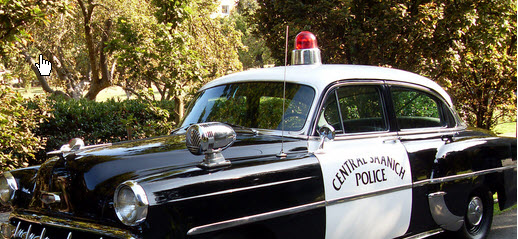 |
Jack Ganssle's Blog This is Jack's outlet for thoughts about designing and programming embedded systems. It's a complement to my bi-weekly newsletter The Embedded Muse.
Contact me at jack@ganssle.com. I'm an old-timer engineer who still finds the field endlessly fascinating (bio).
This is Jack's outlet for thoughts about designing and programming embedded systems. It's a complement to my bi-weekly newsletter The Embedded Muse.
Contact me at jack@ganssle.com. I'm an old-timer engineer who still finds the field endlessly fascinating (bio). |
LIDAR in Cars - Really?
February 11, 2019
Pretty much all of the candidate autonomous cars driving around sport a LIDAR sensor mounted like an old-fashioned "cherry top" on a police vehicle.

A recent article in Electronic Design (by, of course, a LIDAR vendor) gives 11 myths about LIDAR in automotive applications, The default assumption in that article, and elsewhere, is that LIDAR is a critical component for autonomous cars.
Why?
It seems to me that LIDAR has some devastating flaws in this application. Like how do you put a car top carrier over the LIDAR without compromising its field of view? Where will that surfboard go?
The cited article claims that as its use becomes more widespread costs will fall to "a couple of hundred dollars." That's an awful lot of money for a single component in a mass-produced device like an automobile. Realistically, if LIDAR is indeed so critical to the safe operation of a car then redundancy will be needed. When one sensor assembly starts to get anywhere near the thousand-dollar mark it will be uneconomical in a $20-$40k product. Toss in redundant computers, RADARs, other sensors and actuators and one wonders if there will be a budget for tires and the engine.
We do know of a sensor that, after over a century of being integrated into cars, works pretty darn well: eyeballs. Most of us have two, which gives decent depth perception. I'd wager that absent stupid driving behavior (e.g., excessive speed, tailgating, and the like) those two optical sensors are just about perfect for automotive applications.
Sure, there are situations where visibility goes to near zero, but LIDAR would be just as blind. The article I mentioned says "A camera becomes rather useless when there isn't enough ambient lighting; and when it's dark, a camera can only see as far as the headlights, which can be quite dangerous." Yet the headlights can see far enough ahead to stop the car safely; just how far down the road must one peer to be safe?
I think cameras, perhaps coupled with RADAR to measure closing rates (today's 77 GHz RADARs cost little), are the ideal sensors for autonomous cars. They're cheap: Digi-Key lists about 100 that go for under five bucks. In automotive quantities that would probably fall to tens of cents. They're so cheap a car could be infested with them, surveying pretty much every angle. One could cluster sub-par cameras each of which is optimized for different conditions: One for bright lights, another for roads so dark they're horror-film fodder.
Though our eyes are situated only inches apart they provide lots of depth perception. Why not position cameras a meter or more apart in a car, yielding an incredible amount of depth information?
The problem with cameras is they generate a flood of data. But that's not intractable. Consider mobile phones: the SoC has hardware designed to analyze the visual field to extract faces and other features.
Long ago when a 32 KB SRAM was expensive a semi vendor told me to design boards with JEDEC outlines for bigger parts. Semiconductor prices fall and planning around today's prices is sometimes unwise. Similarly, the cost to process visual data has been tumbling, and will certainly continue to fall.
For some insight into how the microprocessor world evolved, see this. |
Will cameras do well in all driving conditions? Of course not. Black ice or zero visibility will always be dangerous. Perhaps future smart cars will need a moron mode which determines the only safe option is to stay in the driveway or pull over.
(I've long been enthusiastic about autonomous cars, but lately am having some second thoughts. How does a car understand that it makes sense to obey the cop waving one through an intersection where the light is red? What if there are several police officers handling traffic from multiple directions? Or how to merge from a 12-lane tollbooth into three lanes where there are no painted guide lines? Though I'm sure these sorts of problems will be solved, they are very complex.)
Feel free to email me with comments.
Back to Jack's blog index page.
If you'd like to post a comment without logging in, click in the "Name" box under "Or sign up with Disqus" and click on "I'd rather post as a guest."
Recent blog postings:
- Non Compos Mentis - Thoughts on dementia.
- Solution to the Automotive Chip Shortage - why use an MCU when a Core I7 would work?
- The WIRECARE - A nice circuit tester
- Marvelous Magnetic Machines - A cool book about making motors
- Over-Reliance on GPS - It's a great system but is a single point of failure
- Spies in Our Email - Email abuse from our trusted friends
- A Canticle for Leibowitz - One of my favorite books.
- A 72123 beats per minute heart rate - Is it possible?
- Networking Did Not Start With The IoT! - Despite what the marketing folks claim
- In-Circuit Emulators - Does anyone remember ICEs?
- My GP-8E Computer - About my first (working!) computer
- Humility - On The Death of Expertise and what this means for engineering
- On Checklists - Relying on memory is a fool's errand. Effective people use checklists.
- Why Does Software Cost So Much? - An exploration of this nagging question.
- Is the Future All Linux and Raspberry Pi? - Will we stop slinging bits and diddling registers?
- Will Coronavirus Spell the End of Open Offices - How can we continue to work in these sorts of conditions?
- Problems in Ramping Up Ventilator Production - It's not as easy as some think.
- Lessons from a Failure - what we can learn when a car wash goes wrong.
- Life in the Time of Coronavirus - how are you faring?
- Superintelligence - A review of Nick Bostrom's book on AI.
- A Lack of Forethought - Y2K redux
- How Projects Get Out of Control - Think requirements churn is only for software?
- 2019's Most Important Lesson. The 737 Max disasters should teach us one lesson.
- On Retiring - It's not quite that time, but slowing down makes sense. For me.
- On Discipline - The one thing I think many teams need...
- Data Seems to Have No Value - At least, that's the way people treat it.
- Apollo 11 and Navigation - In 1969 the astronauts used a sextant. Some of us still do.
- Definitions Part 2 - More fun definitions of embedded systems terms.
- Definitions - A list of (funny) definitions of embedded systems terms.
- On Meta-Politics - Where has thoughtful discourse gone?
- Millennials and Tools - It seems that many millennials are unable to fix anything.
- Crappy Tech Journalism - The trade press is suffering from so much cost-cutting that it does a poor job of educating engineers.
- Tech and Us - I worry that our technology is more than our human nature can manage.
- On Cataracts - Cataract surgery isn't as awful as it sounds.
- Can AI Replace Firmware - A thought: instead of writing code, is the future training AIs?
- Customer non-Support - How to tick off your customers in one easy lesson.
- Learn to Code in 3 Weeks! - Firmware is not simply about coding.
- We Shoot For The Moon - a new and interesting book about the Apollo moon program.
- On Expert Witness Work - Expert work is fascinating but can be quite the hassle.
- Married To The Team - Working in a team is a lot like marriage.
- Will We Ever Get Quantum Computers - Despite the hype, some feel quantum computing may never be practical.
- Apollo 11, The Movie - A review of a great new movie.
- Goto Considered Necessary - Edsger Dijkstra recants on his seminal paper
- GPS Will Fail - In April GPS will have its own Y2K problem. Unbelievable.
- LIDAR in Cars - Really? - Maybe there are better ideas.
- Why Did You Become an Engineer? - This is the best career ever.
- Software Process Improvement for Firmware - What goes on in an SPI audit?
- 50 Years of Ham Radio - 2019 marks 50 years of ham radio for me.
- Medical Device Lawsuits - They're on the rise, and firmware is part of the problem.
- A retrospective on 2018 - My marketing data for 2018, including web traffic and TEM information.
- Remembering Circuit Theory - Electronics is fun, and reviewing a textbook is pretty interesting.
- R vs D - Too many of us conflate research and development
- Engineer or Scientist? - Which are you? John Q. Public has a hard time telling the difference.
- A New, Low-Tech, Use for Computers - I never would have imagined this use for computers.
- NASA's Lost Software Engineering Lessons - Lessons learned, lessons lost.
- The Cost of Firmware - A Scary Story! - A hallowean story to terrify.
- A Review of First Man, the Movie - The book was great. The movie? Nope.
- A Review of The Overstory - One of the most remarkable novels I've read in a long time.
- What I Learned About Successful Consulting - Lessons learned about successful consulting.
- Low Power Mischief - Ultra-low power systems are trickier to design than most realize.
- Thoughts on Firmware Seminars - Better Firmware Faster resonates with a lot of people.
- On Evil - The Internet has brought the worst out in many.
- My Toothbrush has Modes - What! A lousy toothbrush has a UI?
- Review of SUNBURST and LUMINARY: An Apollo Memoir - A good book about the LM's code.
- Fun With Transmission Lines - Generating a step with no electronics.
- On N-Version Programming - Can we improve reliability through redundancy? Maybe not.
- On USB v. Bench Scopes - USB scopes are nice, but I'll stick with bench models.

